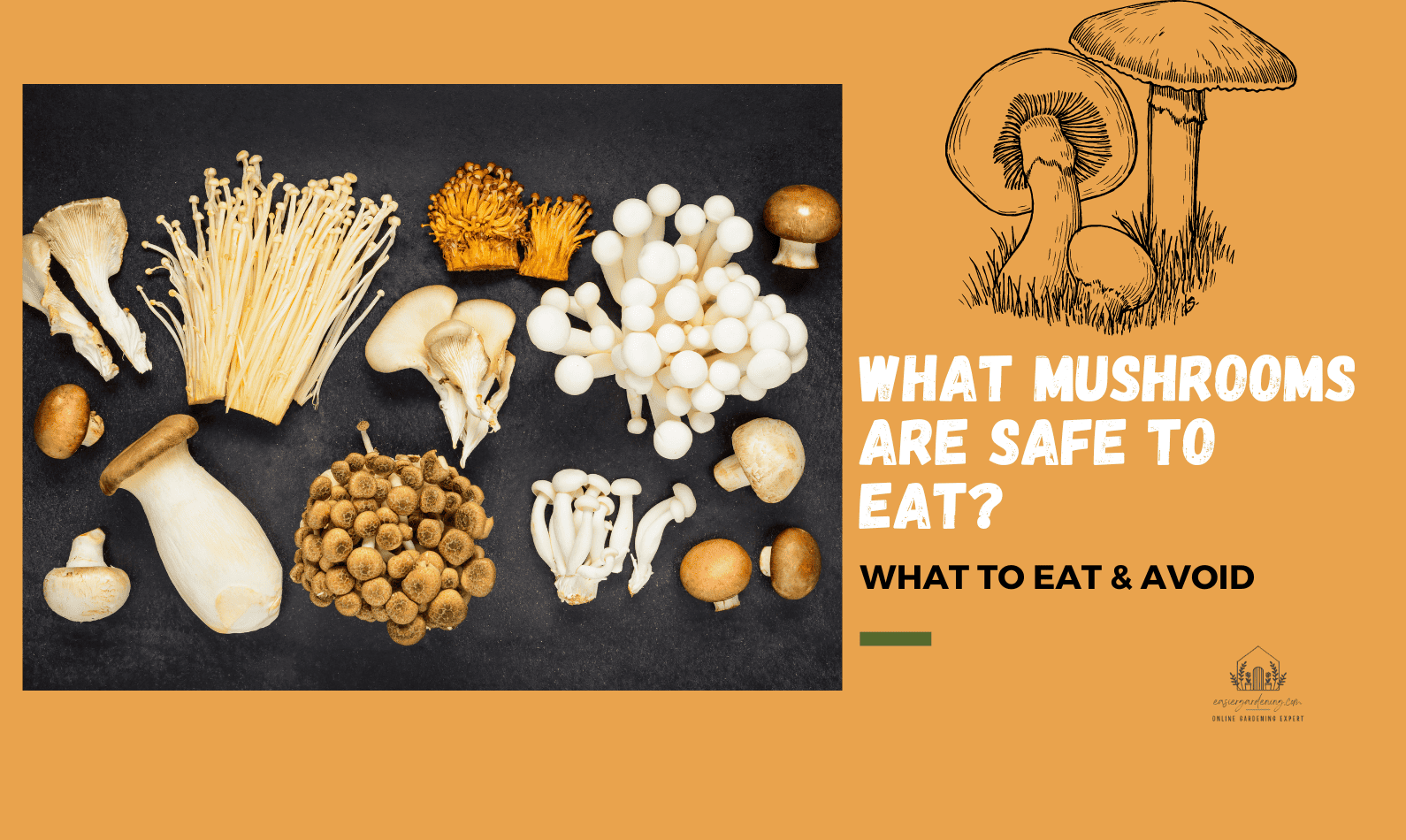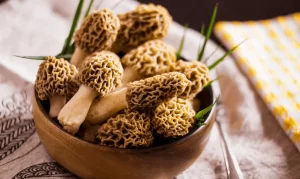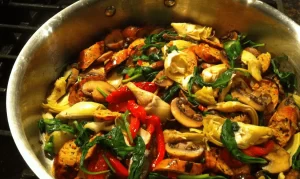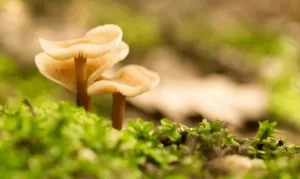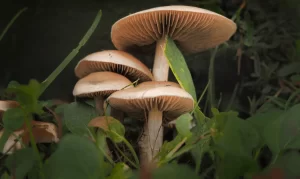What Mushrooms Are Safe to Eat?: Mushroom hunting is a fun way to spend time outdoors and learn about nature. In the United States, edible mushrooms abound, including delectable chanterelles and morels.
Mushroom hunting can also be risky since many mushrooms look the same. It’s all too quick to gather the wrong mushrooms, which can have disastrous (or even fatal) effects. When in doubt, throw out the mushrooms.
It is best to learn mushroom hunting and identification from a professional (or at least a detailed mushroom guidebook). Don’t just browse at a few images and go out to sample the shrooms; do your homework on lookalikes, distinguishing features, set, and storage. To properly identify edible mushrooms, staining and spore examination can be needed – this is why it is critical to seek assistance! Without further ado, let’s look at some of the most common (and delicious) edible mushrooms in the United States!
Contents
- What Mushrooms Are Safe to Eat?
- Morel Mushrooms (Morchella esculenta)
- Chanterelle (Cantharellus cibarus)
- Fairy Ring Mushroom (Marasmius oreades)
- Hedgehog Mushroom (Hydnum repandum)
- Meadow Mushroom/Field Mushroom (Agaricus campestris)
- Shaggy Mane Mushroom (Coprinus comatus)
- Hen of the Wood (Grifola frondosa)
- Bear’s Head Tooth (Genus Hericium)
- Giant Puffballs (Calvatia gigantea)
- Chicken Mushroom (Laetiporus sulphureus)
- Black Trumpet Mushroom (Craterellus cornucopioides)
- Conclusion: What Mushrooms Are Safe to Eat?
What Mushrooms Are Safe to Eat?
Morel Mushrooms (Morchella esculenta)
- Range: Found in much of the United States, especially under hardwood trees in orchards, burn areas and disturbed areas.
- Harvest Season: A brief period in the spring – the exact window varies depending on the venue.
- Identifying Features: A distinctive “honeycombed” cap that is heavily wrinkled and yellow-grey. The middle is hollow. 2 to 9 centimeters in height by 2 to 5 centimeters in thickness.
- Dangerous Lookalikes: Only a few mushrooms have a honeycombed top. When in doubt, toss them out.
- Preparation: A strong flavor that is best cooked in butter and is often served with leeks.
Chanterelle (Cantharellus cibarus)
- Range: Found primarily in coniferous forests in North America, Eurasia, Central America, and Africa (but may be found in grasslands, mountainous birch forests, or beech forests, depending on the location and specific species). They usually form clumps among the moss.
- Harvest Season: Late summer to December, depending on location and plants.
- Identifying Features: Yellow or golden mushrooms that are funnel-shaped and meaty. Gill-like ridges extend down the stem from beneath the cap. Chanterelles may have a fruity, woody, or earthy aroma.
- Dangerous Lookalikes: The fake chanterelle is darker (almost orangeish) in color, with a darker core that fades to light edges. It is not poisonous, but it tastes bad and can cause stomach upset. Chanterelles may be mistaken for Jack-o-lantern mushrooms. A jack-o-lantern mushroom’s gills are much smaller, deeper, and delicate than a chanterelle’s smooth, blunt, and shallow gill-like ridges. Jack-o-lantern mushrooms are poisonous.
- Preparation: Chanterelles have a slightly peppery flavor that can be prepared in a variety of ways. They’re very rich, and they’re frequently made with butter, wine, or cream.
Fairy Ring Mushroom (Marasmius oreades)
- Range: Found in North America. Grows best in grassy areas such as lawns, parks, and even dunes. They sometimes develop in craters where stumps once stood.
- Harvest Season: Summer and fall, but can be grown all year in warm climates.
- Identifying Features: These tiny mushrooms form a ring or an arc. The cap is usually 1 to 5 centimeters in diameter. When the mushroom is young, the cap can be slightly inrolled, but as it matures, it becomes upturned. The cap has been characterized as having a nipple-like shape with a prominent base. The fairy ring mushroom is dry and bald, with a pale tan or buff coloration (but maybe white). The stem is sturdy (one of the most reliable identifying features for this edible mushroom) and may or may not be attached to the gills. The print of the spores will be white. More information on identifying fairy ring mushrooms can be found here.
- Dangerous Lookalikes: Clitocybe dealbata is similar but lacks a tough stem. The gills are much busier than the fairy ring (which has well-spaced gills).
- Preparation: Remove the stem while leaving the cap intact. If necessary, rinse with cold water before allowing it to dry. Since they don’t have a strong flavor, use simpler recipes to let their flavor shine.
Hedgehog Mushroom (Hydnum repandum)
- Range: This species has been found in North America, Europe, Australia, and northern Asia.
- Harvest Season: Summer and autumn are the seasons for harvesting.
- Identifying Features: The wood hedgehog has spines or teeth on the underside of the cap rather than ridged gills – this is the species’ distinguishing feature! It has the appearance of a chanterelle when viewed from above (but is pale orange-ish tan rather than golden in color). This mushroom bruises in dark orange or yellowish-brown color. The shape of the cap varies, but it is usually broadly convex and measures 2 to 17 centimeters across.
- Dangerous Lookalikes: There are no poisonous lookalikes for this species, but it may be confused with similar North American species Hydnum albidum and Hydnum albomagnum.
- Preparation: The taste of the wood hedgehog is sweet and nutty. It has a crunchy texture and can be frozen.
Meadow Mushroom/Field Mushroom (Agaricus campestris)
- Range: This species’ range includes North America, Europe, Asia, northern Africa, and New Zealand. It grows in grassland and may grow alone or in a “fairy ring.”
- Harvest Season: After rain in the spring, summer, or fall.
- Identifying Features: The meadow mushroom has a white cap that measures 5 to 10 centimeters in diameter. When the mushroom matures, the cap flattens. Young mushrooms have pink gills, juvenile mushrooms have reddish-brown gills, and mature mushrooms have dark brown gills. The stipe (stalk) measures 3 to 10 centimeters in height. The mushroom’s flesh bruises to reddish-brown color, and the spore print is a dark brown. Any specimens that do not have distinctive pink gills should be discarded. When it comes to white mushroom varieties, be particularly cautious because there are deadly lookalikes.
- Dangerous Lookalikes: This species is closely related to other species, some of which are lethal and others of which are edible. Amanita virosa is a deadly mushroom that looks like a meadow mushroom when young. A single cap is sufficient to kill a human. The gills and spore print of the deadly Amanita virosa are both white. Amanita bisporigera and Amanita ocreata are two other toxic Amanita species found in North America. The whitish gills and white to pinkish fruiting bodies of A. ocreata distinguish it. A bisporigera has white gills as well. These mushrooms are among the most toxic known to man, causing liver failure.
They’re known as “destroying angel mushrooms” as a group. Agaricus xanthodermus, which causes gastrointestinal upset and can be marked by a yellow stain that occurs in the stipe (stem) when sliced, and Agaricus arvensis, which is also edible, are two other lookalikes. When young, Agaricus arvensis has white gills (like the deadly Amanita virosa), but they turn a dull chocolatey color as it matures. Agaricus arvensis has an anise-like odor. These lookalikes demonstrate why it is important to seek expert assistance while learning to identify mushrooms! - Preparation: This mushroom has a similar flavor to the button mushroom but a shorter shelf life. It’s delicious, sautéed, baked, or even raw on salads.
Shaggy Mane Mushroom (Coprinus comatus)
- Range: Grasslands and meadows in North America and Europe.
- Harvest Season: Harvest season is from June to November, depending on the weather.
- Identifying Characteristics: This species is only edible when young before the gills turn black. It has a shaggy cap that droops over most of the stem and is covered in loose scales when young. The color of the gills rapidly changes from white to pink to black. This species’ gills must be harvested before they turn black.
- Dangerous Lookalikes: The maned agaric is similar to the traditional ink cap, which can cause vomiting, diarrhea, and other unpleasant symptoms if consumed within a few hours of drinking alcohol. The symptoms can be alarming, but they will go away if no more alcohol is consumed. The magnitude of these symptoms is proportional to the amount of alcohol ingested.
- Preparation: Since this mushroom contains a lot of water, it’s a great addition to soups and stocks, such as risotto.
Hen of the Wood (Grifola frondosa)
- Range: This mushroom can be found in China, Japan, and northeastern North America at the base of trees, especially oak trees. It has been mentioned all the way to Idaho.
- Harvest Season: Late summer to early autumn following rain. This is a perennial mushroom that grows in the same location year after year, but only for very short periods of time.
- Identifying Features: This tuber-like mushroom grows in a large clump that some people identify as coral-like. The greyish-brown caps are curled or spoon-shaped. In Japan, the mushroom can grow to weigh up to 100 pounds, but it is usually much smaller. The stalks (stipes) are white and branching. As the mushroom ages, it becomes very tough.
- Dangerous Lookalikes: The Hen of the Woods has no poisonous lookalikes, but it may be confused with Meripilus giganteus, which is also edible. M. giganteus is thicker and has a black mark around the edges.
- Preparation: Harvest with a knife – a large one is needed for cutting this mushroom. For the best flavor and texture, harvest the mushroom when it is young. This mushroom is popular in Japanese cuisine and is delicious sautéed in butter or olive oil or as part of a variety of dishes.
Bear’s Head Tooth (Genus Hericium)
- Range: These species can be found all over the world but are most common in the north in alpine or deciduous forests. They, like many other mushrooms, thrive in shaded areas on rotting logs.
- Harvest Season: Autumn is the harvest season.
- Identifying Features: This mushroom can resemble hundreds of tiny icicles hanging from a log or the mushroom’s sturdy stalks. It has a distinct flavor. The mushroom’s white sections are all edible.
- Dangerous Lookalikes: All four North American species are edible. Dangerous doppelgangers may occur in other parts of the world.
- Preparation: Cook in butter or use later in the winter in soups.
Giant Puffballs (Calvatia gigantea)
- Range: The giant puffball lives in temperate regions all over the world, often in meadows, fields, and deciduous forests.
- Harvest Season: Late summer to early fall is the harvest season.
- Identifying Features: Giant puffballs typically grow to be 10 to 50 centimeters across, but they have been confirmed to grow up to 150 centimeters across! A mature giant puffball’s interior is greenish-brown. When they’re young, the inside flesh is white rather than greenish-brown, and they’re edible. When they reach maturity, they are extremely dangerous to consume!
- Dangerous Lookalikes: All real puffball species are edible as children but poisonous as adults. Until eating, cut them open to ensure they are white. The problem is that when puffballs are young, they can look like many other types of mushrooms, including those that are extremely poisonous. Break the mushroom open to tell them apart. Puffballs would have a solid white interior, while lookalikes may have a different color scheme. Other poisonous lookalikes have a white interior but reveal the silhouette of a cap or gills when cut – make sure these are missing before feeding. Giant puffballs are often confused with earth balls, particularly in the United Kingdom.
Earth balls are darker on the inside when they are young, but they can still be white. An earthball’s skin is firm and covered with wart-like bumps. Before eating, make sure the puffball is smooth, has a stem, and is white. When in doubt, toss it! - Preparation: Do not wash because this fungus absorbs water. They can be kept in the refrigerator for a few days without losing much consistency.
Read more about How To Grow Button Mushrooms Without A Kit?
Chicken Mushroom (Laetiporus sulphureus)
- Range: Grows on dead or mature oak trees and many other hardwood plants, mostly east of the Rocky Mountains.
- Harvest Season: Generally, in the autumn, but can be found from spring to summer if the climate is favorable.
- Identifying Features: There are no gills on this bracket mushroom. It has a big orange or salmon-pink top and a bright yellow underside. They grow in clumps along the trunks of various trees, mainly oaks. Make certain that you can correctly classify the host tree.
- Dangerous Lookalikes: This species can be unsafe to eat if it grows on some trees, if eaten when it is aged, or if cooked incorrectly. Before you dig in, taste little, young, well-cooked bits. Stop specimens growing on a variety of tree species (pine, juniper, spruce, hemlock, eucalyptus, locust, fir, or tamarack). If you can’t be sure of the tree’s identity because it’s gone, play it safe and skip the shroom. Sulfur shelf mushrooms that grow on the described tree species are actually separate, toxic species.
- Preparation: Only the young caps of this mushroom are soft enough to cook with; avoid the rough stem or older specimens. They are well-known for their rich, meaty taste.
Black Trumpet Mushroom (Craterellus cornucopioides)
- Range: Throughout North America, especially in mossy hardwood forests (oak and beech are favorite neighbors). They sometimes develop near washes and streams, preferring damp and dark conditions.
- Harvest Season: Summer and fall, with some places continuing into the winter.
- Identifying Features: These mushrooms grow in leaf litter and can be difficult to spot. They do, however, grow in clusters, so if you spot one, you’re in luck! This mushroom’s cap is a vase- or trumpet-shaped and inky black, dark brown, or grey. There are no gills, pores, or teeth on the underside. The top of the cap may have small scales, but the texture is smooth or slightly wrinkled overall.
- Dangerous Lookalike: There are no dangerous lookalikes – this species is ideal for beginning foragers! The cup-shaped black urn mushroom is not poisonous, but it is not tasty!
- Preparation: These mushrooms have a rich, smoky flavor. Wipe clean, as they are often filthy. It’s fine to give them a fast rinse, but don’t drown them! When dried, they keep their flavor well. They’re delicious sautéed with garlic and oil or powdered and sprinkled on soup or grains.
Conclusion: What Mushrooms Are Safe to Eat?
When it comes to mushroom hunting, remember the Dunning-Kruger effect. This effect teaches us that we always have overconfidence in our abilities when they are, in fact lacking and that we only become modest when we know how difficult something is!
Read more about How Hard Is It to Grow Mushrooms?
To better recognize mushrooms, seek expert assistance and use gills, spore prints, and cuttings. There may be some dangerous lookalikes in your town, so local knowledge is essential!

